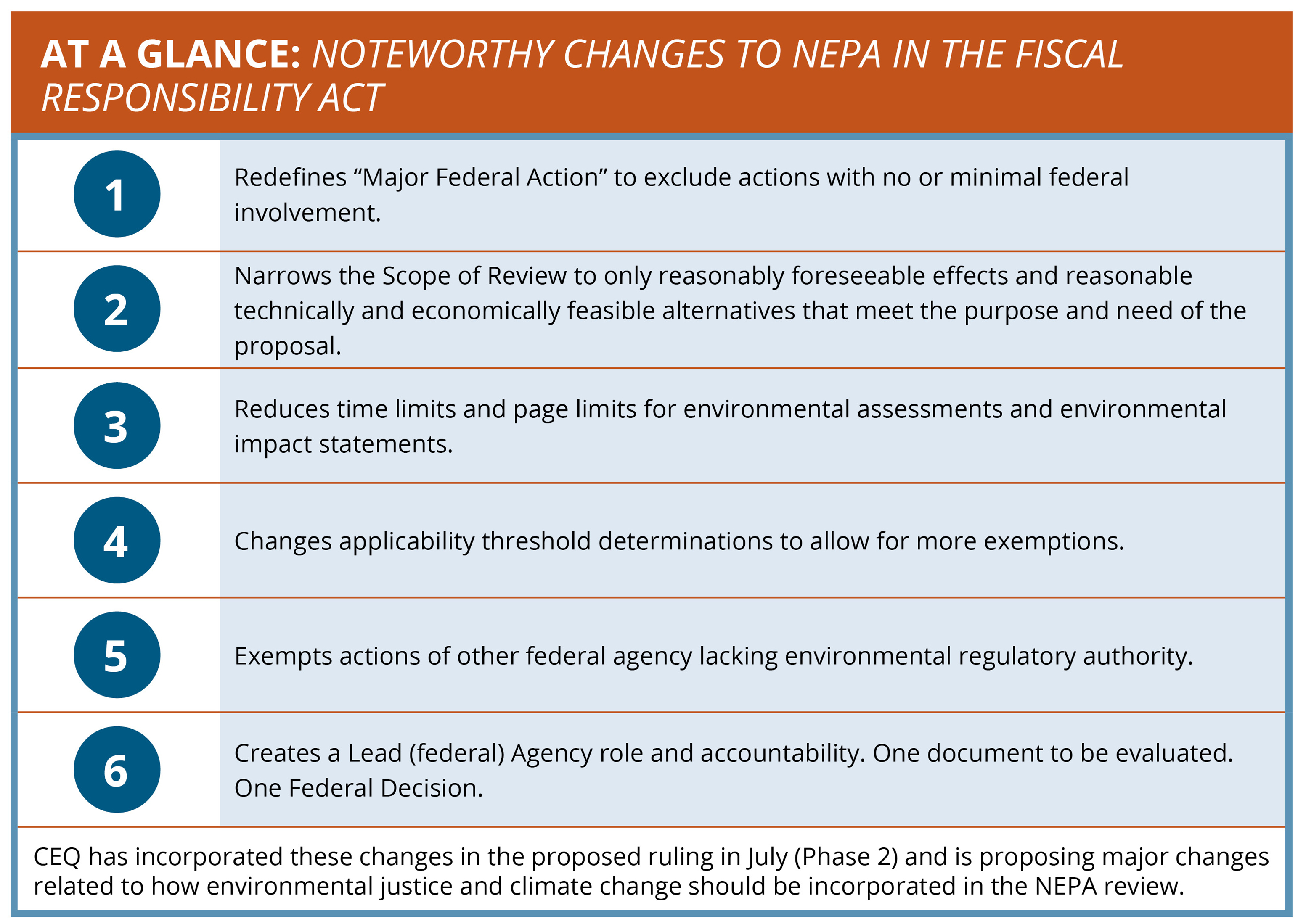National Environmental Policy Act (NEPA) Sees Major Changes
August 15th, 2023
Background
NEPA requires federal agencies to review the potential environmental effects of activities with federal government involvement (such as federal funding or permitting) prior to issuing decisions. The range of actions covered by NEPA is broad and includes federal permitting, adopting federal land management actions, federal funding and constructing highways and other publicly owned facilities.[i]
Changes to NEPA include refining what projects are subject to review, limiting the breadth of project-related alternatives analyses, and capping review times. Regulatory review under NEPA that have been in place for decades are being upended by these changes as Congress has placed new limits on applicability, scope, and schedule. Further, the White House has proposed explicitly addressing environmental justice and climate change in NEPA reviews. This push-and-pull between the legislative and executive branches alters the regulatory landscape for large and small projects alike, across the country.
The intent of these changes outlined in the bill (see Division C: Grow The Economy; Title III: Permitting Reform)[ii] is to streamline the federal review process by clarifying several critical and often contentious elements of NEPA including the scope of the NEPA review, the imposition of time limits on the NEPA review process, and the narrowing of several definitions covering key aspects of the Act.
The changes to NEPA, as outlined in the FRA, are intended to support a more efficient and transparent review process. With the new regulatory implementation rules published on July 28 (as part of the Phase 2 rulemaking), CEQ is now also looking to codify, for the first time, principles of climate change and environmental justice. Here we highlight key changes to NEPA resulting from the passage of the FRA, and proposed Phase 2 implementation rules.
Summary of Major Statutory Changes to NEPA in the Fiscal Responsibility Act of 2023
- Redefining “Major Federal Action”: Previously, NEPA defined a “major federal action” as “potentially subject to Federal control and responsibility.” The new definition is an action that the lead federal agency “determines is subject to substantial Federal control and responsibility.” This means that any action with no or minimal federal involvement or funding is now excluded from this definition, and, therefore, from the requirements of NEPA.
- Narrowing the Scope of Review: NEPA’s scope previously included any
environmental impact requiring a federal action. Now, NEPA is required only for “reasonably foreseeable” effects. In addition, alternatives analyses are now limited to “a reasonable range of alternatives,” which are “technically and economically feasible and meet the “purpose and need of the proposal.” Further, the lead federal agency is tasked with identifying only the irreversible and irretrievable commitments of “Federal resources,” rather than just “resources”. The aim of these changes is to simplify the NEPA review and reduce the regulatory burden for a Proponent.
- Changes to Time and Page Limits: Both the time limits associated with NEPA review as well as the page limits for NEPA environmental documents have been specified. An environmental assessment is limited to one year and 75 pages (excluding appendices), and an environmental impact statement is limited to two years and 150 pages, unless the project is deemed to be of “extraordinary complexity”. While the time limits provide some measure of schedule certainty for completion of the NEPA process, there is concern that federal agencies could use completeness determinations and information requests as a means to delay the implementation of the schedule.
- Applicability: New guidelines have been added for federal agencies to consider threshold determination for NEPA applicability. These guidelines provide exemptions for actions that are excluded by another federal agency, are not final, are nondiscretionary or where the federal agency lacks authority to consider environmental effects. These changes aim to narrow the scope of NEPA review by requiring a higher threshold for justification of an EA/EIS.
- Changes to Agency Hierarchy: This change specifies the establishment of a lead federal agency with the intention of better coordination among federal agencies with permitting and/or consultation roles on a project. The lead federal agency would be responsible for developing the NEPA document (EA / EIS) and would initiate consultation and solicit comments / feedback from the other federal agencies including federally recognized Native American Tribes. This effectively codifies the “One Federal Decision” requirement for a single environmental document that is evaluated by both the lead and any supporting federal agencies.
White House Proposed Phase 2 Rule Open For Comment
In July, the CEQ published a proposed rule known as ‘The Bipartisan Permitting Reform Implementation Rule’ (Phase 2 Rule). This proposed rule would “fully implement and build upon new permitting efficiencies directed by Congress under the Fiscal Responsibility Act of 2023.”[iii] The proposed rule adds two major requirements to the NEPA review process:
- Environmental Justice: While Environmental Justice (EJ) has been part of the prior established NEPA process, the Phase 2 Rule would codify the definition of EJ, would incorporate EJ as part of the scope for alternatives analyses, and would incorporate EJ in the definition of effects.
- Climate change: As with the EJ policy, the Phase 2 Rule would codify policies related to climate change by incorporating climate change in the alternatives analysis as well as the definition of effects.
What Next?
Federal agencies will likely require several months to interpret and clarify changes to NEPA included in the Fiscal Responsibility Act , as well as the proposed CEQ amendments, particularly regarding EJ and climate change. Impacts on federal permitting requirements and timelines, especially for electric transmission, oil and gas pipelines, and various energy projects (including clean energy projects) remain unclear. While the goal of the new provisions is to streamline the NEPA process resulting in fewer regulatory delays, many of the affected federal agencies do not have experience with being the lead agency on a project which may result in schedule delays as they become familiar with the new requirements and coordination processes.
Reducing Uncertainty
While the affected federal agencies work through the changes to the NEPA review process, Project proponents can plan for this uncertainty by ensuring that there is adequate upfront due diligence, early agency outreach and robust analyses conducted with respect to potential project-related impacts on environmental resources.
Changes to NEPA within the Fiscal Responsibility Act are now law. Comments on the Proposed Phase 2 Rule are due by September 29, 2023. CEQ is holding virtual hearings on August 26 and August 30, September 11 and September 21. Information about joining these public meetings will be available at https://ceq.doe.gov/

Background: National Environmental Policy Act
The National Environmental Policy Act (NEPA) was signed into law on January 1, 1970 by President Richard M. Nixon. Congress enacted NEPA to establish a national policy for the environment, provide for the establishment of the Council on Environmental Quality (CEQ), and for other purposes. NEPA was the first major environmental law in the United States and is often called the "Magna Carta" of Federal environmental laws. NEPA requires Federal agencies to assess the environmental effects of proposed major Federal actions prior to making decisions.[iv]
The range of actions covered by NEPA is broad and includes making decisions on permit applications, adopting federal land management actions and constructing highways and other publicly owned facilities. Using the NEPA process, agencies evaluate the environmental and related social and economic effects of their proposed actions. Agencies also provide opportunities for public review and comment on those evaluations.
The US Environmental Protection Agency (EPA) has responsibility to prepare its own NEPA documents for compliance. EPA is charged under Section 309 of the Clean Air Act to review the environmental impact statements (EIS) of other federal agencies and to comment on the adequacy and the acceptability of the environmental impacts of the proposed action. EPA also serves as the repository through its EIS database for EISs prepared by federal agencies and provides notice of its availability in the Federal Register.[v]
Background: The Council on Environmental Quality
NEPA established CEQ within the Executive Office of the President to ensure that Federal agencies meet their obligations under NEPA. CEQ oversees NEPA implementation, principally through issuing guidance and interpreting regulations that implement NEPA's procedural requirements. CEQ also reviews and approves Federal agency NEPA procedures, approves alternative arrangements for compliance with NEPA for emergencies, and helps to resolve disputes between Federal agencies and with other governmental entities and members of the public. One of CEQ's major responsibilities is also to develop and recommend national policies to the President that promote the improvement of environmental quality and meet the Nation's goals. For more information on CEQ initiatives, please visit WhiteHouse.gov/CEQ.[vi]
Key Players

Sonja Sax, M. S., Sc.D, is an environmental health scientist who specializes in evaluating exposure and health risk from environmental pollutants. Dr. Sax has over 20 years of experience in environmental regulatory assessment, health impact assessment and cost-benefit analyses. Sonja has managed large multi-year projects advocating for clients involved in litigation or providing permitting support. She has performed indoor and outdoor air quality investigations evaluating exposures and health impacts of airborne gases and particles. In 2019, she served as an advisor to the US EPA Clean Air Scientific Advisory Committee for the particulate matter and ozone National Ambient Air Quality Standards.
A.J. Jablonowski is a Principal with Epsilon Associates and leader of its Air Permitting Group. He reviews operations at a variety of industrial and power facilities and recommends process changes for regulatory compliance. A.J.’s work includes environmental licensing, compliance and due diligence audits, air permit applications, pollution control studies, accidental release prevention, and regulatory applicability studies.


John Zimmer is a Principal with Epsilon Associates and member of its Offshore Wind and Ecological Sciences Groups. John serves as project manager and regulatory liaison for large-scale energy infrastructure projects involving multi-year permitting efforts including several proposed offshore wind development projects. He is responsible for the preparation of federal, state, and local permit/license applications and coordination and management of field studies including wetland delineation and rare species surveys.
